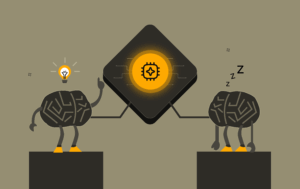“We didn’t get where we are today by design, we got here by stumbling and trying things. And occasionally people would get lucky and everybody would say, oh, they’re a genius.” –Daniel Buzzo
In the world of interaction design, what lies beneath the surface is often the most important aspect of the user experience. The way people think about what they want to do and the underlying design that enables that action is what truly drives the interaction. The user interface, whether it be a physical machine or a digital screen, is simply the manifestation of that design.
Unfortunately, those outside of the field often fail to recognize the importance of what lies beneath the surface, and instead focus solely on the visible user interface. This is where the experience of the user comes into play. As explained in the book “The Experience of Technology” by British writers Right and McCarthy, we don’t simply use technology, we experience it. Our interactions with technology are an integral part of our daily lives, and the design that enables those interactions is what truly shapes our experiences.
“We don’t use technology, we experience it, just like everything in our lives. We don’t use coffee, or tea, or knives and forks, we experience them, we don’t use food, we experience it,” says Daniel.
A truly profound and insightful conversation with our podcast guest Daniel Buzzo, helped us understand the nuances of interaction design and explore the future of design with machine learning and artificial intelligence on the horizon. Read on to learn Buzzo’s views on some emerging sectors in design.
Machine Learning and Artificial Intelligence in Design
In the world of digital products, pre-programming all the responses can be expensive, time-consuming, and ultimately boring. However, if we give the system a range of possibilities within the parameters of what the user would expect, we can create nuanced, subtle, and textured responses that vary slightly every time. This is where the power of generative design, randomness, stochastic functions, and Markov chains comes into play. By using these techniques, we can create logical pieces that vary greatly in terms of complexity and procedural generation. These concepts are being harnessed by designers to create exciting new material, particularly with the rise of machine learning and artificial intelligence. As a result, we’re starting to see the practical applications of these techniques being discussed more seriously, and it’s an exciting time to be in the design field.
Generative Design
“I imagined that I could program the computer in some way that it would start making new things that I’ve never heard or seen before,“ says Daniel.
The idea of creating complexity through simple rules is a thrilling concept that has been explored in the art for centuries. Musicians like Tchaikovsky experimented with assembling short musical phrases in countless permutations to create a diverse range of sounds. This theme has now carried over into the world of generative design, where the possibilities are endless. The practical applications of generative design go beyond simply generating text, sound, or visual material. Architects are now utilizing generative design to explore thousands of permutations of building arrangements and simulate how people would navigate and interact within those spaces. The potential of generative design in commercial applications is vast and exciting, and it’s incredible to see how this technique is being embraced by various industries to enhance creativity and innovation.
Research through Design
In the field of physics, the behavior of molecules can be predicted and modeled in a clear and precise way. Similarly, engineering problems can often be reduced to a single optimal solution. However, when it comes to designing for humans, things get more complex. In their writings, Riffle and Vabre described this as a “wicked problem” — a problem that is difficult, if not impossible to solve because of constantly changing circumstances and the involvement of people. As digital designers, we need to keep in mind that the needs and problems we design for today may not be the same tomorrow and that the people we are designing for may change as well. Furthermore, the act of designing something to solve a problem can change the situation. This is why design is a generative process, and why we need to constantly ideate, analyze, and work in collaboration with the people who use the things we create. Daniel concludes by saying,
“Research through design is that the artifacts or things that we make can be vehicles for research themselves.”
Human-Computer Interaction (HCI)
Daniel quotes Johnny Ive from Apple saying,
“When you design something, you must remember that you’re designing two products, the one that you design and the one that the users use.”
In designing computer systems, understanding how humans interact with technology is fundamental. While the term “human-computer interaction” may be considered outdated, it still accurately describes the nature of people interacting with computer systems. It is essential to consider the physical and mental ergonomics of computer systems, just as it is important to consider them in physically-oriented products such as cars and chairs. Neglecting this principle can result in dysfunctional products that are uncomfortable to use and may even cause harm. Human-centered design is crucial for building functional products that are user-friendly and enhance the overall user experience.
Final Thoughts
We’re sure you’ve gotten some real gems from Daniel’s wealth of knowledge on interaction design. His strong foundation in the fundamentals of design, coupled with his forward-thinking perspective on emerging technologies, aids in fostering a comprehensive understanding of design as a discipline.
Want to learn more from the professor of Interaction Design, Daniel Buzzo? Listen to the full episode of the UX Banter podcast where our host Dushyant Kanungo and Daniel touches on interesting topics on design and more.
Listen to the full episode here:
The Actual Interaction Design Is Underneath! — Daniel Buzzo
Follow UX Banter on Spotify and stay tuned for more such inspiring and insightful conversations with UX industry experts.


























